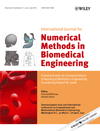
International Journal for Numerical Methods in Biomedical Engineering
Scope & Guideline
Empowering Research with Cutting-edge Numerical Methods
Introduction
Aims and Scopes
- Computational Modeling in Biomedicine:
The journal emphasizes the use of computational models to simulate biological processes and medical interventions, including fluid dynamics in cardiovascular systems and biomechanical behavior of tissues. - Numerical Methods for Medical Applications:
It provides a platform for innovative numerical methods tailored for biomedical applications, such as finite element analysis, computational fluid dynamics, and machine learning techniques to enhance diagnostic and therapeutic processes. - Interdisciplinary Research:
Encouraging interdisciplinary collaboration, the journal integrates insights from engineering, biology, and medicine, promoting research that addresses complex health challenges through diverse methodologies. - Focus on Patient-Specific Solutions:
A significant aim is to develop personalized computational models that can predict individual patient outcomes, thereby supporting tailored treatment plans and improving clinical decision-making. - Advancements in Imaging and Data Analysis:
The journal covers advancements in imaging technologies and data analysis methods, particularly in how they can be applied to enhance the understanding of biological phenomena and improve diagnostic accuracy.
Trending and Emerging
- Machine Learning and AI in Biomedicine:
There is a significant increase in publications utilizing machine learning and artificial intelligence to analyze medical data, optimize treatment plans, and develop predictive models for patient outcomes. - Personalized Medicine and Patient-Specific Modeling:
The trend towards personalized medicine is evident, with a growing body of work focusing on developing computational models tailored to individual patients, which enhances treatment efficacy and safety. - Fluid-Structure Interaction Studies:
Research on fluid-structure interactions, particularly in cardiovascular applications, is gaining traction, reflecting the complexity of biological systems and the need for integrated modeling approaches. - Advancements in Imaging Technologies:
Emerging themes include the use of advanced imaging technologies combined with computational modeling to improve diagnostic capabilities and treatment planning, particularly in areas such as cancer and cardiovascular diseases. - Robust Uncertainty Quantification:
There is a rising emphasis on uncertainty quantification in computational models, addressing the variability in biological systems and enhancing the reliability of model predictions in clinical settings.
Declining or Waning
- Basic Biological Modeling:
There has been a noticeable decline in publications focused exclusively on basic biological modeling, as researchers increasingly seek to apply complex models to specific clinical scenarios rather than studying biological systems in isolation. - Traditional Mechanical Testing Approaches:
Research focusing solely on traditional mechanical testing methods, such as static analysis, is becoming less common, as there is a growing preference for dynamic, computationally intensive approaches that provide more comprehensive insights. - Single-Domain Modeling:
The journal has seen a reduction in studies emphasizing single-domain modeling approaches. There is a shift toward more integrated, multi-domain models that capture the interactions between different physiological systems. - Conventional Statistical Methods:
The use of conventional statistical methods for analyzing biomedical data is declining as machine learning and advanced computational techniques gain prominence in extracting insights from complex datasets. - Static Imaging Techniques:
Research centered on static imaging techniques is waning, as dynamic imaging modalities and real-time data analysis become more relevant for understanding physiological processes.
Similar Journals
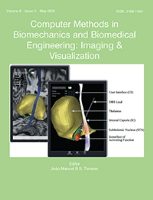
Computer Methods in Biomechanics and Biomedical Engineering-Imaging and Visualization
Unveiling the Future of Medical Imaging and VisualizationComputer Methods in Biomechanics and Biomedical Engineering - Imaging and Visualization is a prominent academic journal published by Taylor & Francis Ltd, dedicated to the intersection of computational methods and biomedical engineering. With an ISSN of 2168-1163 and an E-ISSN of 2168-1171, the journal has become a crucial resource for researchers and professionals exploring innovative imaging and visualization techniques in healthcare. Covering a broad spectrum of topics, it aims to facilitate the advancement of knowledge in areas such as biomechanics, computational mechanics, and medical imaging. Holding a strong position in various Scopus rankings, including Q2 in Computational Mechanics, it offers valuable insights that foster interdisciplinary collaboration. Although it is not an open-access journal, researchers can access its rich repository of knowledge, which is instrumental in shaping future advancements in biomedical applications. The journal’s commitment to quality and relevance ensures that it remains an authoritative source for emerging trends and methodologies within the field, serving as a vital tool for academia and industry practitioners alike.
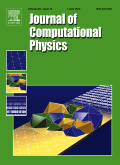
JOURNAL OF COMPUTATIONAL PHYSICS
Pioneering Research in Computational TechniquesJOURNAL OF COMPUTATIONAL PHYSICS, an esteemed publication from ACADEMIC PRESS INC ELSEVIER SCIENCE, serves as a premier platform in the field of computational physics and its interdisciplinary applications. Since its inception in 1966, the journal has provided invaluable insights and significant advancements in areas such as applied mathematics, numerical analysis, and modeling and simulation. With a robust impact factor and ranking in the top quartile across various related categories, including Q1 in Applied Mathematics and Physics and Astronomy, it is essential reading for researchers and professionals aiming to stay at the forefront of computational techniques and methodologies. Although the journal is not open access, it remains highly regarded with a reputation for rigorous peer review and high-quality publications. As the field continues to evolve, the JOURNAL OF COMPUTATIONAL PHYSICS highlights innovative research that not only advances theoretical constructs but also offers practical applications in scientific and engineering domains. For scholars and students, this journal embodies a critical resource for deepening their understanding and fostering dialogue within the scientific community.

International Journal of Numerical Analysis and Modeling
Exploring the Depths of Numerical AnalysisThe International Journal of Numerical Analysis and Modeling, published by ISCI-INST SCIENTIFIC COMPUTING & INFORMATION, is a leading platform for research in the field of numerical analysis. With an ISSN of 1705-5105 and an E-ISSN of 1705-5105, this esteemed journal has been disseminating rigorous and innovative studies since its inception in 2004. Covering a diverse range of topics within numerical analysis, it has successfully positioned itself in Q2 of the 2023 category quartiles and ranks 46th out of 88 in its Scopus classification, showcasing its relevance and impact within the academic community. Operating under an open access model, it ensures that research findings are accessible to a global audience, fostering collaboration and knowledge exchange. Based in Canada, this journal not only highlights advancements in computational methodologies but also addresses real-world applications, bridging theoretical frameworks with practical solutions. Researchers, professionals, and students alike will find valuable insights and up-to-date contributions in this crucial field of study.

COMPUTATIONAL MECHANICS
Transforming Theory into Practice in EngineeringCOMPUTATIONAL MECHANICS, published by SPRINGER, is a premier international journal that focuses on the intersection of applied mathematics, engineering, and computational methods. With a commendable Q1 ranking in multiple categories, including Applied Mathematics and Mechanical Engineering, this journal is pivotal for disseminating groundbreaking research and innovative methodologies that advance the field. The journal has steadily contributed to the academic community since its inception in 1986 and continues to lead discussions and practices in computational mechanics and related disciplines. With a robust impact reflected in its Scopus rankings—placing it within the top percentiles across various categories—COMPUTATIONAL MECHANICS serves as a crucial platform for researchers, professionals, and students seeking to explore and contribute to significant advancements in computational theory and mathematical applications. Although it does not currently operate under an open access model, the journal ensures wide accessibility through libraries and institutional subscriptions, fostering a rich exchange of knowledge in the global scientific community.

Computational Methods for Differential Equations
Unlocking New Frontiers in Differential Equation ResearchComputational Methods for Differential Equations is a prominent academic journal dedicated to the exploration and application of computational techniques in the realm of differential equations. Published by UNIV TABRIZ, this open-access journal has been providing unrestricted access to groundbreaking research since 2013, making it a valuable resource for the global academic community, particularly in Iran. It has carved out a niche within the fields of Algebra and Number Theory, Applied Mathematics, and Numerical Analysis, maintaining a Q3 quartile ranking in 2023 across these categories. Researchers, professionals, and students alike will find the journal's commitment to disseminating innovative computational methodologies essential for advancing knowledge and developing robust solutions to complex mathematical problems. With its ISSN 2345-3982 and E-ISSN 2383-2533, the journal ensures wide visibility and accessibility, serving a diverse audience and promoting scholarly discourse.
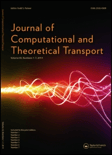
Journal of Computational and Theoretical Transport
Unveiling the Dynamics of Computational TransportJournal of Computational and Theoretical Transport, published by Taylor & Francis Inc, is a dedicated platform for researchers and professionals in the fields of applied mathematics, mathematical physics, and transportation. Since its inception in 2013, this journal has offered valuable insights into computational and theoretical approaches to transport phenomena, bridging various scientific disciplines and fostering interdisciplinary collaborations. While the journal currently holds a Q4 ranking in categories such as Applied Mathematics and Statistical and Nonlinear Physics, it aims to elevate the quality of research published in these areas through rigorous peer review and a commitment to advancing knowledge. The university-sponsored studies, which cover a wide spectrum of transport models and their applications, make it a vital resource for students and academics alike. Positioned within the United Kingdom, this journal continues to attract a global readership interested in the latest developments and theoretical advancements in transportation science. With no open access option, readers can expect high-quality, curated content that reflects ongoing research trends and methodologies, contributing to the broader field of physics and engineering.
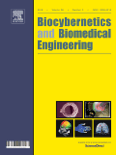
Biocybernetics and Biomedical Engineering
Transforming Healthcare Through Cutting-Edge EngineeringBiocybernetics and Biomedical Engineering, published by ELSEVIER in the Netherlands, is a prestigious journal that stands at the forefront of the intersecting fields of biomedical engineering and artificial intelligence. With an impressive Impact Factor that places it in the Q1 category for Biomedical Engineering, this journal not only ranks 17th out of 303 in Scopus but also boasts a remarkable percentile ranking of 94th, highlighting its influence and relevance within the scientific community. Since its inception in 2008, Biocybernetics and Biomedical Engineering has aimed to publish cutting-edge research that integrates principles of cybernetics with technological advancements in health care, thereby fostering innovations that improve patient outcomes. Dedicated to advancing knowledge in biomedical technology, the journal serves as a vital resource for researchers, professionals, and students seeking to explore the latest developments and methodologies in the field.
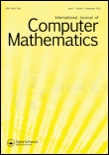
INTERNATIONAL JOURNAL OF COMPUTER MATHEMATICS
Unveiling New Methodologies in Computational MathematicsThe International Journal of Computer Mathematics, published by Taylor & Francis Ltd, stands as a prominent forum for the dissemination of novel research in the intersection of mathematics and computing. Established in 1964, this journal has evolved significantly, contributing to the field with robust methodologies and innovative applications. It holds notable rankings within Scopus, classified as Q2 in Applied Mathematics and Q3 in both Computational Theory and Mathematics and Computer Science Applications for 2023, highlighting its pivotal role in advancing academic discourse. Though it is not an open-access journal, its rigorous peer-review process ensures that published articles maintain the highest scholarly standards, making it a reliable source for cutting-edge research. Researchers, professionals, and students alike will find valuable insights and advancements that push the boundaries of mathematical applications in computing, solidifying its importance within the mathematical and computer science communities.

JOURNAL OF SCIENTIFIC COMPUTING
Connecting Theory and Practice in Scientific ComputingJOURNAL OF SCIENTIFIC COMPUTING, published by Springer/Plenum Publishers, stands as a premier venue for disseminating innovative research in the domains of applied mathematics, computational mathematics, and numerical analysis, among others. With an illustrious history spanning from 1986 to 2024, this journal has established itself as a vital resource for scholars and practitioners, reflected in its Q1 status in multiple categories including Applied Mathematics and Software, as per the 2023 rankings. The journal features a rigorous peer-review process, ensuring high-quality publications that contribute to the advancement of theoretical and practical knowledge in scientific computing. Although not open access, the journal provides critical insights and methodologies that are invaluable for advancing computational techniques in engineering and mathematics. With impressive Scopus rankings, including being in the 78th percentile for Numerical Analysis, JOURNAL OF SCIENTIFIC COMPUTING is essential reading for researchers, professionals, and students aiming to stay at the forefront of scientific innovation.

Numerical Mathematics-Theory Methods and Applications
Advancing Numerical Insights for Tomorrow's ChallengesNumerical Mathematics: Theory Methods and Applications, published by GLOBAL SCIENCE PRESS, stands as a pivotal journal in the fields of applied and computational mathematics, control and optimization, as well as modeling and simulation. With an ISSN of 1004-8979 and an E-ISSN of 2079-7338, this journal has been committed to disseminating high-quality research since its establishment in 2010, curating contributions that reflect the latest advancements in numerical methodologies and their diverse applications. As a Q2 journal in its category for 2023, it ranks favorably in the Scopus metrics, with notable positions in various mathematical disciplines. Although it does not currently provide open access, it remains an essential resource for researchers and professionals seeking to deepen their understanding of numerical methods and their applications. The journal’s esteemed reputation, coupled with its strategic focus on emerging trends in mathematics, makes it an invaluable platform for scholars who wish to contribute to and stay informed about cutting-edge developments in this dynamic field.